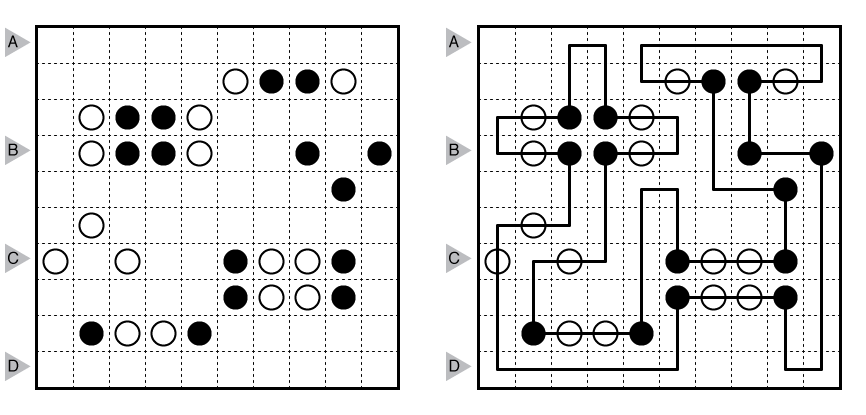Masyu Rules and Info

Rules: Draw a single, non-intersecting loop that passes through all circled cells. The loop must go straight through the cells with white circles, with a turn in at least one of the cells immediately before/after each white circle. The loop must make a turn in all the black circles, but must go straight in both cells immediately before/after each black circle.
Answer String: Enter the length in cells of the horizontal loop segments from left to right in the marked rows, starting at the top. If the loop only has vertical segments in the marked row, enter 0. Separate each row’s entry with a comma. This example has the key “15,222,23,51”.
(Brief) History of Masyu: Masyu was first published in 2000 by Nikoli in quarterly Communication 90; the original authors were 矢野龍王 (Yano Ryuoh) and アセトニトリル (“Acetonitrile”). Masyu followed an earlier loop puzzle that used only the white circle rule. The original name was Shiro Shinju Kuro Shinju (“White Pearl Black Pearl”), but a misreading of the kanji for shinju by the president of Nikoli gave it the name Masyu meaning “Evil Influence”.
History of this example: This “twisted symmetry” Masyu was written by Thomas Snyder for the 20/10 Puzzle Decathlon.
Sources for Masyu Puzzles: Follow this link for classic Masyu puzzles on this website and this link for variations on Masyu puzzles. If you are new to this puzzle type, here are our easiest Masyu Puzzles to get started on. More Masyu puzzles can be found on nikoli.com, where the puzzle originated, in The Art of Puzzles, and in our beginner-friendly book Logic Puzzles 101.
Design rules for contributors: A Grandmaster Masyu will have a unique solution that can be reached by logic alone. Generally, a Grandmaster Masyu should have an interesting visual theme or an interesting solution, but no requirements of symmetry exist. Sizes from 10×10 and above are recommended (maximum aspect ratio of 2:1 if rectangular).

“Enter the length in cells of the loop segments from left-to-right in the marked rows, starting at the top.”
Clarify the meaning of “length in cells”. It could be taken to mean that the top row should be 26, since the first segment occupies 2 cells, and the second segment occupies 6.
Since the loop passes from midpoint of cell to midpoint of cell, the length of the loop segments will be one less than your count. I’ve copied the LMI format, if not their exact language, but that is why I give a specific enumerated example to clarify.